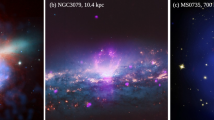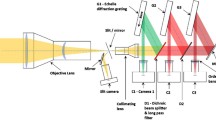Abstract
The Interface Region Imaging Spectrograph (IRIS) of the recently commissioned NASA small explorer mission provides significantly more complete and higher resolution spectral coverage of the dynamical conditions inside the chromosphere and transition region (TR) than has been available ever before. High temporal, spatial (\(0.3''\)) and spectral resolution observations from the ultraviolet IRIS spectra near the solar limb reveal high-energy limb event brightenings (LEBs) at low chromospheric heights at about 1 Mm above the limb. They can be characterized as explosive events producing jets. We selected two events showing spectra of a confined eruption just off or near the quiet-Sun limb, the jet part showing obvious moving material with short-duration large Doppler shifts in three directions that were identified as macrospicules on slit-jaw (SJ) images in Si iv and He ii 304 Å. The events were analyzed from a sequence of very close rasters taken near the central meridian and the South Pole limb. We analyzed the processed SJ images and the simultaneously observed fast spectral sequences, which have large Doppler shifts, with a pair of redshifted elements together with a faster blueshifted element from almost the same position. Shifts correspond to velocities of up to \(100~\mbox{km}\,\mbox{s}^{-1}\) in projection on the plane of the sky. Erupting spicules and macrospicules from these regions are visible in images taken before and after the spectra. The cool low first ionization potential (FIP) element simultaneous line emissions of the Mg ii h and k resonance lines do not clearly show a similar signature because of optical thickness effects, but the Si iv broadband SJ images do. The bidirectional plasma jets ejected from a small reconnection site are interpreted to be the result of coronal loop–loop interactions that lead to reconnection in nearby sites.
















Similar content being viewed by others
References
Alissandrakis, C., Zachariadis, Th., Gontikakis, C.: 2005, In: Proc. 11th ESPM, ESA SP-596.
Aschwanden, M.: 2004, Physics of the Solar Corona, An Introduction, Springer, Praxis Publishing, Chichester. ISBN 3-540-22321-5.
Bohlin, J.D., Vogel, S.N., Purcell, J.D., Sheeley, N.R. Jr., Tousey, R., Vanhoosier, M.E.: 1975, Astrophys. J. 197, L133. DOI .
Brueckner, G.E.: 1980, In: Highlights in Astron. Reidel Publ. 5, 557.
Brueckner, G.E., Bartoe, J.-D.F.: 1983, Astrophys. J. 272, 329. DOI .
Cirtain, J.W., Golub, L., Lundquist, L., van Ballegooijen, A., Savcheva, A., Shimojo, A., et al.: 2007, Science 318, 1580. DOI .
Daw, A., DeLuca, E.E., Golub, L.: 1995, Astrophys. J. 453, 929. DOI .
De Pontieu, B., Title, A.M., Lemen, J.R., Kushner, G.D., Akin, D.J., Allard, B., et al.: 2014, Solar Phys. 289, 2733. DOI .
Dere, K.P., Bartoe, J.-D., Brueckner, G.E.: 1989, Solar Phys. 123, 41. DOI .
Filippov, B., Golub, L., Koutchmy, S.: 2009, Solar Phys. 254, 259. DOI .
Filippov, B., Koutchmy, S., Golub, L.: 2009, Geomagn. Aeron. 49, 1109. DOI .
Filippov, B., Koutchmy, S., Tavabi, E.: 2013, Solar Phys. 286, 143. DOI .
Georgakilas, A.A., Koutchmy, S., Alissandrakis, C.F.: 1999, Astron. Astrophys. 341, 610.
Golub, L., Krieger, A.S., Silk, J.K., Timothy, A.F., Vaiana, G.S.: 1974, Astrophys. J. 189, L93. DOI .
Innes, D.E., Inhester, B., Axford, W.I., Wilhelm, K.: 1997, Nature 386, 811. DOI .
Judge, P.G.: 2000, Astrophys. J. 531, 585. DOI .
Koutchmy, S., Loucif, M.: 1991, In: Mechanism of Chrom. and Coronal Heating, Conf. Heidelberg, Ulmschneider, Priest and Rosner Ed., Springer, Berlin, 152.
Koutchmy, S., Stellmacher, G.: 1976, Solar Phys. 49, 253. DOI .
Koutchmy, S., Koutvitsky, V.A., Molodensky, M.M., Soloviev, L.S., Koutchmy, O.: 1994, Space Sci. Rev. 70, 283. DOI .
Koutchmy, S., Hara, H.., Suematsu, Y., Reardon, K.: 1997, Astron. Astrophys. 320, L33.
Moore, R.L., Tang, F., Bohlin, J.D., Golub, L.: 1977, Astrophys. J. 218, 286. DOI .
Moore, R.L., Cirtain, J.W., Sterling, A.C., Falconer, D.A.: 2010, Astrophys. J. 720, 757. DOI .
Pasachoff, J.M., Jacobson, W.A., Sterling, A.C.: 2009, Solar Phys. 260, 59. DOI .
Peter, H., Tian, H., Curdt, W., Schmit, D., Innes, D., De Pontieu, B., et al.: 2014, Science 346, 315. DOI .
Roussev, I., Galsgaard, K., Erdelyi, R., Doyle, J.G.: 2001, Astron. Astrophys. 375, 228. DOI .
Sekse, D.H., Rouppe van der Voort, L., De Pontieu, B.: 2012, Astrophys. J. 752, 108. DOI .
Shimojo, M., Hashimoto, S., Shibata, K., Hirayama, T., Hudson, H.S., Acton, L.W.: 1996, Publ. Astron. Soc. Japan 48, 123. DOI .
Singh, K.A.P., Isobe, H., Nishida, K., Shibata, K.: 2012, Astrophys. J. 760, 28. DOI .
Sterling, A.C.: 2000, Solar Phys. 196, 79. DOI .
Sterling, A.C., Moore, R.L., DeForest, C.E.: 2010, Astrophys. J. 714, L1. DOI .
Suematsu, Y., Wang, H., Zirin, H.: 1995, Astrophys. J. 450, 411. DOI .
Tavabi, E.: 2014, Astrophys. Space Sci. 350, 489. DOI .
Tavabi, E., Koutchmy, S., Ajabshirizadeh, A.: 2012, JMP 3, 1786. DOI .
Tavabi, E., Koutchmy, S., Ajabshirzadeh, A.: 2011, New Astron. 16, 296. DOI .
Tavabi, E., Koutchmy, S., Ajabshirizadeh, A., Ahangarzadeh Maralani, A.R., Zeighami, S.: 2015, Astron. Astrophys. 573, 7. DOI .
Tsiropoula, G., Alissandrakis, C.E., Schmieder, B.: 1994, Astron. Astrophys. 290, 285.
Tsiropoula, G., Tziotziou, K.: 2004, Astron. Astrophys. 424, 279. DOI .
Tsiropoula, G., Tziotziou, K., Kontogiannis, I., Madjarska, M.S., Doyle, J.G., Suematsu, Y.: 2012, Space Sci. Rev. 169, 181. DOI .
Yokoyama, T., Shibata, K.: 1995, Nature 375, 42. DOI .
Zirin, H., Cameron, R.: 1998, In: Guyenne, T.D. (ed.) Solar Jets and Coronal Plumes SP-421, ESA, Noordwijk, 39.
Acknowledgements
IRIS is a NASA small explorer mission developed and operated by LMSAL with mission operations executed at NASA ARC with contribution from NSC (Norway). We thank T.M.D. Pereira for his very useful online tutorial for IRIS data analysis ( http://folk.uio.no/tiago/naoj2014_exercises/tutorials.html ). We are indebted to Boris Filippov, Igor Veselovsky, and Jean-Claude Vial for making meaningful remarks on the paper. We warmly acknowledge the work of our referee, who provided an extended detailed report and added many interesting suggestions and requests. This work has been supported by the Institut d’Astrophysique de Paris-CNRS and UPMC. LG was supported by a contract from Lockheed Martin to SAO.
Author information
Authors and Affiliations
Corresponding author
Rights and permissions
About this article
Cite this article
Tavabi, E., Koutchmy, S. & Golub, L. Limb Event Brightenings and Fast Ejection Using IRIS Mission Observations. Sol Phys 290, 2871–2887 (2015). https://doi.org/10.1007/s11207-015-0771-3
Received:
Accepted:
Published:
Issue Date:
DOI: https://doi.org/10.1007/s11207-015-0771-3




